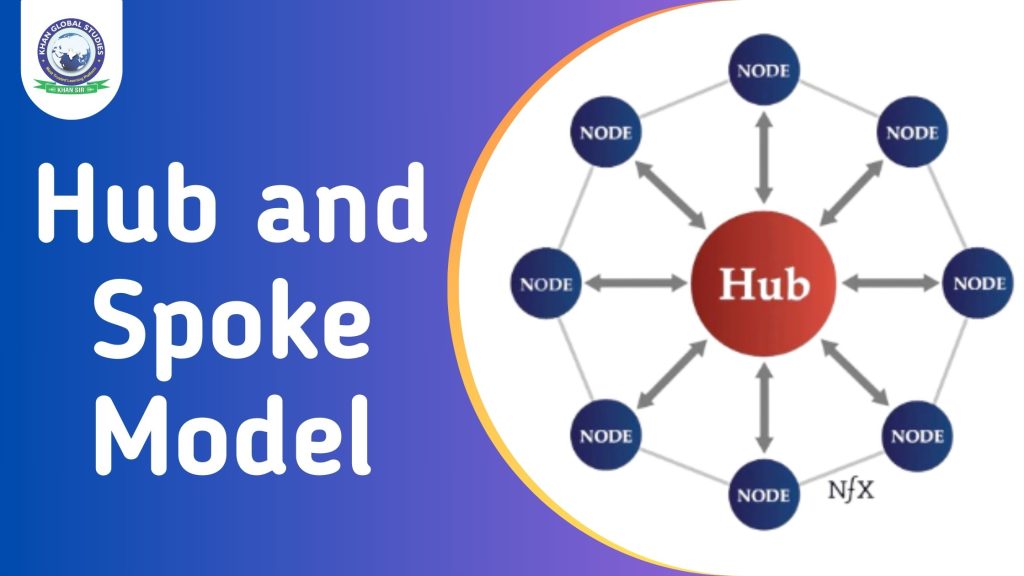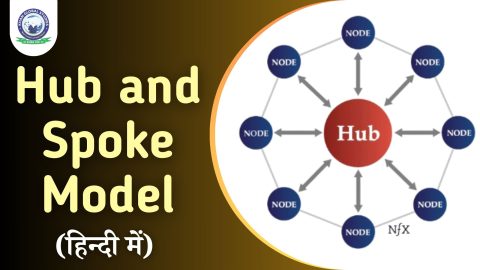The ‘Hub and Spoke’ model is a strategic framework that has revolutionized various industries by centralizing operations and optimizing efficiency. Originally conceptualized for transportation and logistics, this model has since been adopted across a range of sectors from telecommunications to retail. In this article, we will explore the intricacies of the ‘Hub and Spoke’ model, its applications, benefits, challenges, and its relevance in today’s dynamic business environment.
Definition of the ‘Hub and Spoke’ Model
The ‘Hub and Spoke’ model is a system where a central hub (core) connects to various spokes (secondary points). In this configuration, the hub serves as the primary center for operations, facilitating the flow of goods, services, or information from the spokes. The spokes represent external points that are connected to the hub but not directly to each other.
How the Model Works?
Hub
The hub serves as the focal point of the model, where all critical activities are concentrated. It is the central location where resources are collected, processes are streamlined and decisions are made. In a transportation context, the hub is the main terminal where cargo or passengers are collected before being sent to their final destination via spokes.
Spokes
Spokes are external points connected to the hub. These can be distribution centers, retail shops or regional offices, depending on the industry. Spokes depend on the hub for resources and coordination but operate semi-independently to serve their respective regions or markets.
Key Features
- Centralization: One of the defining features of the model is centralization. All critical functions such as decision-making, inventory management and customer service are centralized at the hub. This ensures consistency and efficiency across the network.
- Efficient Resource Allocation: By centralizing resources at the hub, organizations can allocate them more efficiently. This reduces redundancy, lowers costs and ensures resources are available when and where they are needed most.
- Scalability: The ‘Hub and Spoke’ model is inherently scalable. As a business grows, new spokes can be added to the network without overhauling the entire system. This makes it an attractive option for organizations looking to expand their operations.
Applications of the ‘Hub and Spoke’ Model
- Transportation and logistics: The ‘Hub and Spoke’ model is perhaps best known for its application in transportation and logistics.
- Airlines: Major airlines such as Delta and American Airlines use the ‘Hub and Spoke’ model to streamline their operations. By routing flights through a central hub, they can offer more destinations with fewer aircraft, which reduces operating costs and increases efficiency.
- Shipping and freight: In the shipping and freight industry, companies such as FedEx and UPS use the ‘Hub and Spoke’ model to manage their logistics network. Packages are collected from various locations (spokes) and transported to a central hub for sorting and distribution.
- Telecommunications: Telecommunications companies use the ‘Hub and Spoke’ model to manage their network. The hub is a central exchange, where data is processed and sent to various local exchanges (spokes), which serve different customers.
- Healthcare: In healthcare, the ‘Hub and Spoke’ model is used to centralize specialized services at major hospitals (hub), while smaller clinics (spokes) provide primary care services. Patients are referred to the hub for specialized treatment, ensuring efficient use of resources.
- Retail and Distribution: Retailers use the ‘Hub and Spoke’ model to manage their supply chains. Centralised warehouses (hubs) distribute products to retail stores (spokes), ensuring efficient inventory management and timely delivery.
- Digital Networks and IT: In the field of IT and digital networks, data centers often act as hubs, processing and storing data which is then accessed by users through various devices (spokes). This model enhances data security and ensures faster access to information.
Benefits of the ‘Hub and Spoke’ Model
- Cost Efficiency: By centralizing operations at the hub, organizations can reduce costs associated with redundancy, transportation, and resource management. This makes the ‘Hub and Spoke’ model a cost-effective solution for businesses of all sizes.
- Improved Service Quality: Centralization allows for a uniform service quality across the network. Since all critical functions are managed at the hub, organizations can maintain high standards and ensure that all spokes receive the same level of service.
- Simplified Management: The model simplifies management by centralizing decision-making processes. This reduces the complexity of operations and allows for more streamlined communication and coordination.
- Flexibility and Adaptability: The model is highly flexible and adaptable. New spokes can be added or removed based on the needs of the organization, making it easier to scale and adjust to changes in the market.
Challenges of the ‘Hub and Spoke’ Model
- Excessive Dependence on the Hub: One of the main challenges of the ‘Hub and Spoke’ model is the potential excessive dependence on the hub. If there is a disruption in the hub, the entire network can be affected, causing delays and operational issues.
- Potential Bottlenecks: If the workload at the hub increases, centralization can lead to bottlenecks. This can slow down operations and reduce the overall efficiency of the network.
- Initial Setup Costs: Setting up a hub can require significant initial investment, especially in industries such as transportation and logistics. This can be a barrier for small businesses looking to implement the model.
- Risk Management: Centralization increases the risks associated with disruptions at the hub, whether they are due to natural disasters, technical failures, or other unforeseen events. Effective risk management strategies are essential to mitigate these risks.
Real-World Examples
- FedEx’s Hub and Spoke System: FedEx is a great example of the implementation of the ‘Hub and Spoke’ model. The company uses a central hub in Memphis, Tennessee, to process and deliver packages around the world. This model allows FedEx to provide fast and reliable delivery services, even for international shipments.
- Delta Airlines’ Hub Network: Delta Airlines uses several hubs across the United States to manage its flight operations. By routing flights through these hubs, Delta can serve a wide range of destinations while optimizing aircraft utilization.
- Telecommunications Networks: Telecommunications companies such as AT&T and Verizon use the ‘Hub and Spoke’ model to manage their data networks. Centralized data centres process and route data to local exchanges, ensuring efficient and reliable communication services.
Conclusion
The ‘Hub and Spoke’ model has proven to be a versatile and effective strategy for a wide range of industries, from transportation to digital networks. Its ability to centralize operations, reduce costs, and improve service quality makes it an attractive option for businesses looking to optimize their operations. However, this model also has challenges such as potential bottlenecks and excessive reliance on hubs. Despite these challenges, the ‘Hub and Spoke’ model remains a valuable tool in today’s interconnected world, with a promising future.
Frequently Asked Questions
Question: What is the primary benefit of the ‘Hub and Spoke’ model?
Answer: The primary benefit is cost efficiency, which is achieved through centralization and optimized resource allocation.
Question: How does the ‘Hub and Spoke’ model affect customer service?
Answer: It improves service quality by ensuring consistency across the network with centralized management at the hub.
Question: Can small businesses use the ‘Hub and Spoke’ model?
Answer: Yes, small businesses can use a smaller version of the model to streamline operations and improve efficiency.
Question: Which industries benefit the most from the ‘Hub and Spoke’ model?
Answer: Industries such as transportation, logistics, telecommunications, healthcare, and retail benefit greatly from this model.
Question: Is the ‘Hub and Spoke’ model still relevant today?
Answer: Absolutely. The ‘Hub and Spoke’ model remains highly relevant in today’s interconnected world, offering scalability and efficiency.





